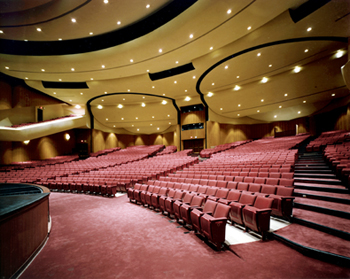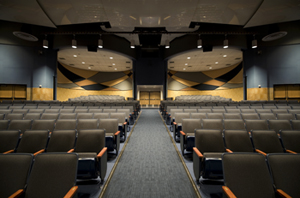Auditorium Turntables: Saving Cost, Creating Space and Adding Functionality
 Jack Shepherd is the architectural and industrial product manager for Macton, Oxford, Conn. Macton has been engineering, fabricating, and installing high quality moving structures since the 1950s.
Jack Shepherd is the architectural and industrial product manager for Macton, Oxford, Conn. Macton has been engineering, fabricating, and installing high quality moving structures since the 1950s.
There are two national trends providing the impetus for new school construction. They are increasing student populations as well as the state of existing buildings that are deteriorating, outdated, and in desperate need of repairs. Yet, many districts are finding that limited budgets and/or land scarcity issues are stonewalling their construction efforts. For schools willing to rethink their design options; however, money and space concerns are being resolved, and quality, learning environments are being realized. By incorporating cost-efficient, multi-use devices, such as Turntable Divisional Auditoriums (TDAs), districts nationwide are satisfying budgets, optimizing space, and adding functionality today and for the future.
According to the United States Census Bureau, public school enrollment has been steadily rising since 1985. In fact, between 1985 and 2010, enrollment for kindergarten through 12th grade rose 25 percent, from 39.4 million to 49.4 million. Also climbing however, are building costs. The National Clearinghouse for Educational Facilities (NCEF) through McGraw Hill Construction reports building costs per square foot are on an upward swing. For example, the average, elementary school construction costs went from $185.37 per square foot in 2010 to $194.60 in 2011, and senior high costs rose from $204.44 to $210.83. Though perhaps insignificant at first glance, numbers like these add up quickly and can be particularly hard to swallow for districts already facing tight budgets. Additionally, according to the 21st Century School Fund, the average K-12 school building in the United Sates is 40 years old. This means new school building construction isn’t just a concern today, but is likely a reality for many years to come.
To address these issues, districts are looking at alternative design options, especially when it comes to constructing large gathering areas such as auditoriums and performance halls. Though considered essential school building components by most, these cavernous spaces require large amounts of land, and consume as much as 90 percent of a school’s energy costs. With this in mind, many districts looking to lower costs and reduce their building footprint are turning to TDAs.
Although at first glance TDAs appear practically space-age, their turntable machinery has been around for 60 years, from automobile shows to revolving restaurants. Though the basic principal remains the same today, in regards to schools, TDAs provide much more than rotating platforms.
To understand how a TDA operates, first picture a typical school auditorium. With rows and rows of stationery chairs and a stage at one end, there is no wiggle room for change. The seating arrangement is static, and the entire space must be heated or cooled every time it’s utilized. Now picture an auditorium where some seats are stationery, while others are positioned on a circular platform (TDA) that can swivel forward for additional seating or swiveled away to reduce the seating capacity. TDAs offer this flexibility and depending upon how many are installed and how wide the platform, they can reconfigure a room to accommodate various audience sizes. Additionally, when turned away from the main portion of the room, with their sound-proof back wall, every TDA becomes a separate classroom, lecture hall, or practice area. However, this multi-functional capability is just the beginning.
As part of a new school construction, TDAs are also cost and land-use efficient. For instance, Kentlake High School in Kent Washington installed two 125 seat TDAs in their 600-seat auditorium, resulting in up to three available educational areas at any given time. By maximizing their available space, Kentlake furthermore eliminated the need for 2,500 additional square feet required for a traditional auditorium, cutting their construction costs significantly. In fact, a study conducted by BLRB Architects, P.S., concluded the school saved 6.3 percent in overall construction costs by installing the multi-functional TDAs. In addition to construction savings, every time the school utilizes the individual TDA thermostats for classes and small groups, instead of heating and cooling the entire auditorium, they reduce their energy costs.
 TDAs additionally increase auditorium usage due to their sound-proof, back wall design. According to Jimmie Byrd, Senior Production Coordinator at the Chandler Center for the Arts in Chandler Arizona "You get more bang for the buck when you can do bigger shows and smaller shows, but you can also do multiple shows.” With two TDAs, the Chandler Center hosts close to 700 events a year (most occurring simultaneously), relying heavily on the TDAs sound-insulated performance areas. Another example is The Ernest Stroud Hall in the Fine Arts Magnet High School in Jonesboro Georgia. Utilizing two TDAs, one with 250 seats and the other 350, The Hall is one of Atlanta’s largest auditoriums, often hosting several hundred events every year. For area schools, the increased functionality provided by the TDAs makes scheduling a dream. But additionally, The Hall’s flexible seating arrangement is ideal for community events and performances and provides an important connection between the school and community.
TDAs additionally increase auditorium usage due to their sound-proof, back wall design. According to Jimmie Byrd, Senior Production Coordinator at the Chandler Center for the Arts in Chandler Arizona "You get more bang for the buck when you can do bigger shows and smaller shows, but you can also do multiple shows.” With two TDAs, the Chandler Center hosts close to 700 events a year (most occurring simultaneously), relying heavily on the TDAs sound-insulated performance areas. Another example is The Ernest Stroud Hall in the Fine Arts Magnet High School in Jonesboro Georgia. Utilizing two TDAs, one with 250 seats and the other 350, The Hall is one of Atlanta’s largest auditoriums, often hosting several hundred events every year. For area schools, the increased functionality provided by the TDAs makes scheduling a dream. But additionally, The Hall’s flexible seating arrangement is ideal for community events and performances and provides an important connection between the school and community.
For today’s school district personnel, the struggle to keep pace with increasing student populations, while juggling tight budgets and limited land options, often produces more stress than action. With the additional need to replace outdated buildings, many districts are seeking more educated construction options for new builds and discovering multi-use, energy-efficient designs are just the ticket. By incorporating unique and practical designs such as TDAs into construction plans, districts nationwide are providing flexible learning environments for their schools and communities and receiving high marks for their efforts.
For more information, please call (203) 267-1500 x231 or send email to jshepherd@macton.com. Website: www.macton.com.
